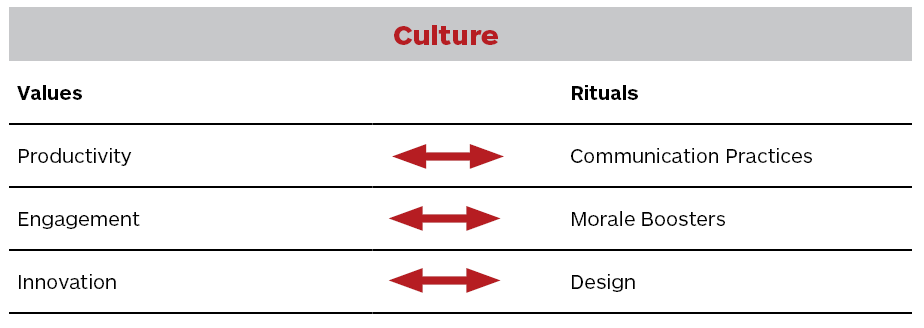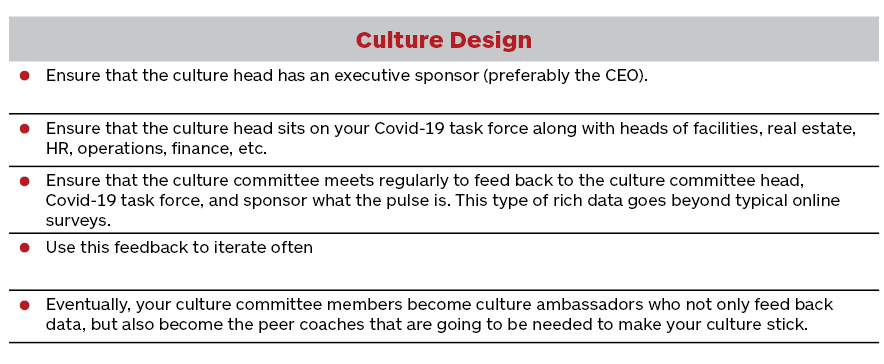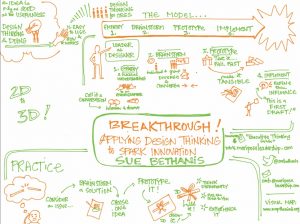UPDATED: Workplace Culture (Now and the Next Normal)
Culture – the cohesiveness that shapes a company. I like to describe culture as the “ways things are around here” and see it as imperative to your company’s success — just like strategy, structure, and operations.
by Sue Bethanis, CEO/Founder of Mariposa, sueb@mariposaleadership.com, @suebethanis
Understandably, in the past month, conscious attention to culture might have fallen by the wayside as your company had to abruptly move from an office work environment to WFH (work from home). You’ve probably been mired in contingency plans and focused on getting situated. If you’re a parent, homeschooling has taken much of your time and energy, and you’re probably still overwhelmed by it (and it’s really okay). Many of you are mastering videoconferencing and finding your team’s productivity sweet spot. Some of you are relishing being at home because fewer distractions equate to higher quality output. And we have heard that for all of you, it’s been tough to create the “water cooler” on Zoom (or Teams or Slack or Hang-outs), and certainly, the “way things are around here” is markedly different now. There is no “here” because there is no office; collaboration is more challenging, cultural artifacts (like snacks to share, those comfy chairs by the window, elevator signage, even the cool color schemes) have faded away; and heightened stress and anxiety from isolation, uncertainty, and/or fear has come into full view.
In this essay, I want to address how you can put more attention on culture now and for the future (the “next” normal); it’s a future that is going to look very different from before Covid-19. If you can put solid practices in place now, and at the same time, design for the future, your team/organization will be better set up for success; you will also be able to cope with stress better and create loyalty and inspiration that will have a lasting effect. Creating consistent cultural rituals, for example, will be the things that people will remember you for. They’ll remember that you checked in with them every week just to be sure they were doing okay. Or that you spent extra time to work out a problem with them regarding a customer. Or that you showed genuine sensitivity when a team member’s loved one got sick.
Let’s look at three areas of culture: 1) consistent communication practices, 2) morale boosters, and 3) design. These practices are associated with three important and far-reaching cultural values: productivity, engagement, and innovation.

Consistent communication practices (to be productive)
Much of what I am going to suggest here are practices we are hearing from our clients. We have a nose-to-the-ground knowledge because Mariposa has 12 coaches who collectively work with approximately 110 leaders, and we have many HR partners. We have a pretty good handle on how tech leaders are coping with Covid-19, and I want to share what we consider the best practices.
Messaging: Clear constant messaging is vital from the top of your company. I can’t emphasize this enough. Make your messaging a newsletter or a personal email and make it weekly. Directs and employees want transparency, and they want to hear from you as often as possible. Further, if you’re not the head of your company, demonstrate clear leadership with your own team, and email/phone/Slack/Zoom to ask the CEO to be consistent and transparent.
Communication Channels/Tools: Review all the ways people can effectively communicate now and get clear about how and when teams will use each method. For example:
- How will they communicate real-time? Phone, vidcon, etc.
- How will they communicate asynchronously? Email, chat, text, etc.
- How will they think visually together?
- How will they share content?
- How will results, recognition, progress be posted/shared?
Meetings: Make all meeting types clear and whatever you were doing before Covid-19, double it; this will demonstrate the value you are putting on communication and connecting. This uptick in communications is not intended to be micro-management; you will need to trust team members and use the time to support and align on expectations and intended outcomes. For example:
- Have a 15-minute daily video huddle at 9 am and end with one at 5 pm. Use it as a way to get clear on goals for the day and any important updates.
- If you used to have 30 minute bi-weekly 1-1s with each of your directs, make them weekly. Ask each time, “how are you doing?” Or “how are you holding up?”
- For team meetings, take the time to let everyone check-in and establish clear agendas, actions, and document any actions taken away. For these check-in’s you might try one question each time and hold people to a minute:
- What’s been hard to navigate lately?
- What’s been a silver lining in WFH?
- What’s an achievement you can share?
- What have you learned about yourself in the last week or two?
- Use a consistent virtual collaboration tool, to keep meetings fresh and ideas plentiful. We like Stormboard.
- You can’t do “walkarounds” anymore, but you can do “call arounds” while you’re taking a walk in your neighborhood. We are hearing that team members are already growing tired of formal video meetings all day. So, pick up the phone and call instead, and suggest that you both walk and talk (or talk and walk). Also, consider this practice for skip-level meetings. Walk&Talks are the one practice that leaders and employees covet the most and the one they hope to continue, for sure.
- Simulate the “water cooler” by using a Slack channel or Zoom for one hour a day. As the leader, you’re there and encourage others to stop by and gather around. (And some very collaborative, smallish teams are keeping a Slack or Zoom channel open from 9-5).
Scheduling: I just outlined a lot of meetings; at the same time, it’s important you don’t over-rotate on meetings. Choose a few and do them well and consistently. Get input from your team(s) and identify scheduling norms that will work for most everyone. (These will likely change as you transition through different phases over the coming months.) The very best tip we have heard from clients is one from a VP of a 200-person service organization: Two weeks into their now eight-week WFH policy, he highly encouraged (instituted) a 9-12, 2-5 meeting schedule. He did this to give time for parents to be with and teach their kids, have lunch with family, and emphasize self-care and mental health. This schedule has contributed to great success. Their overall productivity is up, and they are now planning on a WFH approach for the foreseeable future. It has completely changed their thinking and orientation. Put simply, this has changed their culture.
Morale Boosters (to engage)
Morale is a critical component of culture. It is the outlook, attitude, satisfaction, and confidence that team members feel working together and working for your company. For many, work is not just work; it’s social, too. A lot of people — especially single employees — depend on work colleagues. We have heard Shelter-in-Place has been especially isolating for them. Further, getting creative about coping with isolation is already hitting some roadblocks.
Here are some ideas that our clients have done, and the Mariposa team has generated in a brainstorming session. These morale boosters serve as ongoing cultural rituals that can hopefully carry on once you are “back-to-the-office.”
- For fun:
- Virtual happy and coffee hours have been done a lot. Ask a team member to continue to RIF on it to keep it fresh. Change up the drinks, change up the theme.
- There’s HouseParty – a fun app where a team can get together to enjoy a drink and a game. Give it a try.
- If you haven’t already, try the best mask contest.
- Online gaming together.
- How about sending an inspirational quote every week?
- For learning:
- Send each other articles/blogs/videos that are helpful to culture, leadership, teaming, etc., that you circulate once a week. Ask a team member to curate them in one place. Leading effective remote meetings is a hot topic right now!
- Teach other skills: nutrition, cooking, knitting
- Use a Slack channel for various things: Share self-care routines, parenting tips, movie tips, etc.
- Lead a class: Pilates, yoga, weight training. Share your trainer with teammates.
- For giving and supporting each other:
- One of our clients — a sales director for a small tech firm — uses UberEats gift cards to get time on their customers’ calendars. Surprise your directs, peers, or customers with lunch or dinner delivery or a gift card they can use for a local restaurant. This supports local small businesses, too.
- Encourage your team to take walks with each other in their neighborhoods, walking at least 6 feet apart.
- Use a virtual collaboration tool/whiteboard to post wins, thank you’s, etc.
- Take time in a regular meeting to allow people to give shout-outs, thank-yous.
- Create a chat thread all about recognition.
- Whatever was working before, amp it up in the digital world.
Design (to understand & innovate)
Cultural rituals like consistent communication practices and morale boosters will go a long way to engage and support your employees during WFH. It’s important to keep the pulse on what’s working and not working. There are various ways to do this, and using a design thinking approach will help you determine what of your company/team cultural values and rituals are most important to keep, and what to shift now and in the “next” normal. Putting together a design team (culture committee) is the first step to innovation.
Culture chair and committee Ask someone to be the Culture Head (guru, czar, chair), who facilitates the culture committee. This committee will be in charge of understanding, developing, and sustaining culture values and rituals. The primary role of this group is to be the holder of the secret sauce. Here are some questions the committee can begin with:
- What makes your company or team special?
- What are your most sacred values and principles?
- What is it about the way things were around here (pre-Covid-19) that we want to keep?
- How do we change in our cultural rituals — communication practices and morale boosters — as the work environment shifts?
- What do we want to add now and more?
- How do we keep engagement fresh and fun?
And most importantly, how do you get ongoing feedback, distill it, and continuously feed it back to the sponsor, boss, etc., so adjustments can be made. Using a design thinking (Empathy, Brainstorming, Prototyping, Test) approach will be helpful here. Cultural values and rituals cannot and should not be decided in the back room. It requires many voices and iteration. Experimentation is a healthy way of looking at what’s ahead of us. There will be “rolling blackouts” type situations where WFH and/or WFO (work from office) will be more predominant at various times. This means getting clear NOW on what’s most important in your team/company’s collaboration and communication practices, for example, will make it easier as you navigate the scenarios that come next.
Feedback will be especially important when the transition to the “next” normal happens. Because the next normal will be unlike anything any of us have experienced here in the U.S. Other cultures have some experience with it from the SARS and MERS epidemic, and China is in the midst of coming back to offices now. See an example here.
Dealing with the experience of the “next” normal: The “way things are around here” is going to be very different when it is deemed okay from a public health standpoint to start going back to the office. From my research, the common theme among policymakers is that there is no rush: the curve and testing will determine when the economy should open up. #TestTraceIsolate will become standard in our lexicon, and we should brace ourselves for a pandemic summer that includes physical distancing that could last way beyond the summer months.
Here are some excellent resources to learn more about the public policy planning that emphasizes #TestTraceIsolate.
- Three Harvard’s public health academics view here.
- Former FDA head, Scott Gottlieb, and his team at AEI here.
- Earlier this week, California Governor Gavin Newsom laid out the factors he and his team are using to decide on reopening. He explains reopening businesses will begin slowly when both the curve has not only flattened, but starts to go down, and when testing becomes more ubiquitous. Right now, tests are designated for health care workers and those who show obvious symptoms of Covid-19. Ubiquitous testing translates to approximately 10,000 a day for those who have mild symptoms and for those who might have been exposed to someone who has had Covid-19. This type of testing then is followed by careful tracing of others who have been exposed to those who are positive and then isolating those who are positive (by quarantining). For more details, see press conference here, and summary here.
So what might the first phase after Shelter-in-Place look and feel like? Here is a glimpse into the “next” WFO environment.
- Coming into the office is purely voluntary;
- There will be required temperature checks to come into your building and your floor;
- There will be only 2 people to 1 elevator ride, so you will be waiting in line for elevators;
- There will be physical distancing in cubes and conference rooms (depending on the size of the conference room, that means 2-4 people in conference rooms with others on Zoom);
- Odd floors are used one day; even the next (so there can be a rotation in deep cleaning);
- Alternating when segments of your company/team come in: some come in on MW, others on TTh;
- Touchless doors; touchless coffee makers (does Amazon carry those?);
- Hand sanitizer and wipes at your desk and every conference room, and an expectation that you wipe your chair, table, and equipment down every time you transition;
- Everyone wears face protection at all times;
- You will be happy to go out to lunch with one colleague, grab a sandwich together, and then walk outside to a place where you can sit at least 6 feet apart (well, unless you are freezing your ass off in San Francisco’s July weather — in that case, you will go to a restaurant inside by yourself and sit at least 6 feet apart from the next table over and be greeted with a waiter with face protection).
Picture all of that for a minute. It has a very different feeling than pre-Covid-1, doesn’t it? Safety — both physical and psychological — is paramount. So, in order for a culture committee not to become the culture police, it’s going to take some “experience” design to ensure your culture isn’t sterile, even though the work environment has to be. I have addressed with you previously in this paper the importance of simulating the “water cooler” in the WFH work environment. The same holds true for the new WFO environment: how will you create the “water cooler” in the “next” normal? The culture head and committee should be in charge of this, and brainstorming and prototyping new ideas is key.
The “next” normal is really a hybrid: In addition to coming to grips with how the next office environment is going to be experienced, there is also the issue of having two work environments (WFO and WFH) — and two cultures — being managed at the same time. Preliminary data from our clients suggests that WFH might be preferable for some employees. Some reasons include higher productivity from WFH (more convenience, time, and fewer distractions) and fewer costs (as a VC colleague told me, one of his start-ups could save $10mil in real estate costs). Further, as this article points out and as I outlined above, there is actually a heightened awareness/attention on communication practices out of necessity. Finally, the prospect of office meetings with others — all wearing masks, 6 feet away — might just feel too off-putting for some people.
We all were literally thrown into WFH in a matter of days; and what if this experiment works? Many levels have to be considered here, and many logistics to coordinate. There are tremendous implications for real estate, as well as facilities, and IT. My suggestion is that before this becomes more than an informal nice to have — “gee, I would rather just go into the office 2-3 days instead of 5” — those cultural rituals are considered along with the usual operational and workplace issues. What are the communication practices that will work in this hybrid (WFO and WFH) environment, what are the points of engagement and morale that should be considered, and how do we get continuous feedback to ensure it’s working (through design work).
Creating and sustaining the culture you want in this hybrid environment starts with having an elevated role for a culture head, to put culture central to your company’s success. Here are some more specific suggestions:

I welcome your feedback, questions, and your ideas. Sharing helps everyone. Contact us
To download a PDF of this article, click here.
MORE